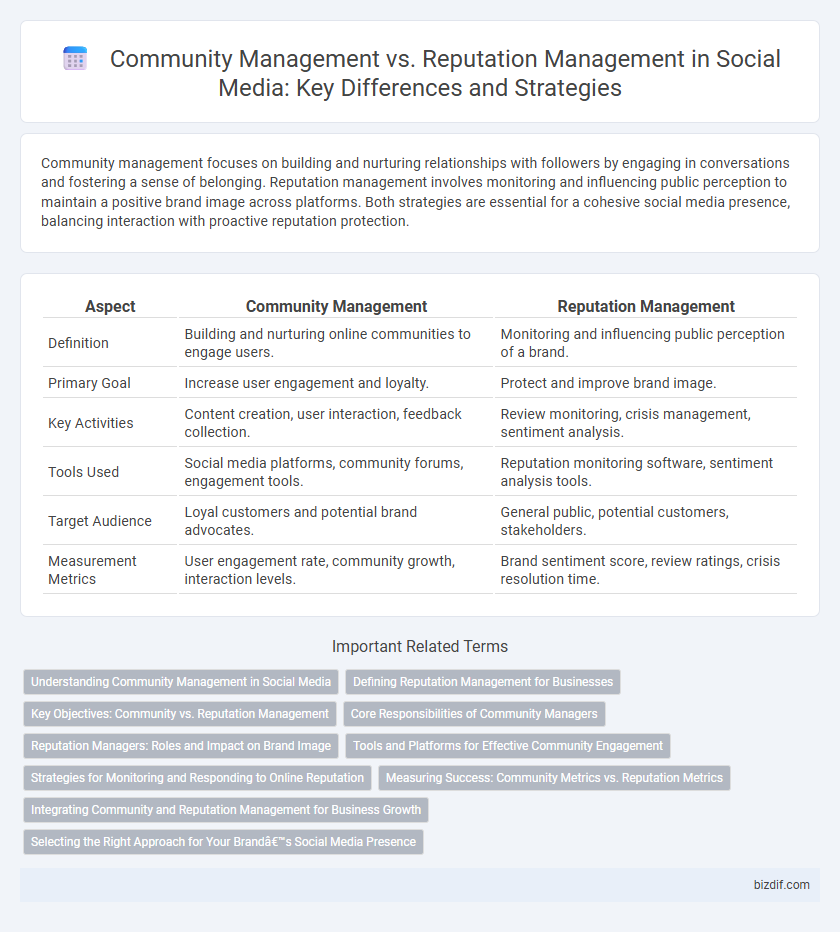Community management focuses on building and nurturing relationships with followers by engaging in conversations and fostering a sense of belonging. Reputation management involves monitoring and influencing public perception to maintain a positive brand image across platforms. Both strategies are essential for a cohesive social media presence, balancing interaction with proactive reputation protection.
Table of Comparison
| Aspect | Community Management | Reputation Management |
|---|---|---|
| Definition | Building and nurturing online communities to engage users. | Monitoring and influencing public perception of a brand. |
| Primary Goal | Increase user engagement and loyalty. | Protect and improve brand image. |
| Key Activities | Content creation, user interaction, feedback collection. | Review monitoring, crisis management, sentiment analysis. |
| Tools Used | Social media platforms, community forums, engagement tools. | Reputation monitoring software, sentiment analysis tools. |
| Target Audience | Loyal customers and potential brand advocates. | General public, potential customers, stakeholders. |
| Measurement Metrics | User engagement rate, community growth, interaction levels. | Brand sentiment score, review ratings, crisis resolution time. |
Understanding Community Management in Social Media
Community management in social media involves actively engaging with users by responding to comments, fostering conversations, and building relationships to create a loyal and interactive audience. Unlike reputation management, which focuses on monitoring and influencing public perception, community management prioritizes nurturing ongoing dialogue and support within the social media platforms. Effective community management enhances brand loyalty, drives organic engagement, and cultivates a sense of belonging among followers.
Defining Reputation Management for Businesses
Reputation management for businesses involves monitoring, influencing, and controlling the public perception of a brand across social media platforms and online channels. It focuses on responding to customer feedback, addressing negative comments promptly, and promoting positive testimonials to build trust and credibility. Effective reputation management helps safeguard a company's image, driving customer loyalty and long-term growth.
Key Objectives: Community vs. Reputation Management
Community management focuses on fostering engagement, building relationships, and nurturing a loyal audience through consistent interaction and content tailored to audience interests. Reputation management prioritizes monitoring, influencing, and improving public perception by addressing negative feedback, promoting positive reviews, and managing brand sentiment across digital platforms. Both strategies employ social listening tools, but community management aims at long-term connection while reputation management targets immediate impact on brand credibility.
Core Responsibilities of Community Managers
Community managers focus on fostering genuine engagement by moderating conversations, responding to audience inquiries, and cultivating a loyal online community across social media platforms. They facilitate meaningful interactions, gather audience feedback, and create content tailored to community interests, strengthening brand affinity and trust. Unlike reputation management, which primarily monitors and addresses public perception and crises, community management centers on building and maintaining active, positive relationships within social networks.
Reputation Managers: Roles and Impact on Brand Image
Reputation managers play a crucial role in shaping and maintaining a brand's public perception through strategic monitoring and response to online reviews, feedback, and social media conversations. By addressing negative comments promptly and promoting positive content, they enhance trust and loyalty among customers, directly impacting brand reputation. Their expertise in crisis management and sentiment analysis ensures that potential threats to brand integrity are mitigated effectively, preserving long-term brand value.
Tools and Platforms for Effective Community Engagement
Tools like Hootsuite, Sprout Social, and Buffer enhance community management by scheduling posts, tracking engagement, and facilitating real-time interactions. Reputation management platforms such as Brand24 and Mention monitor brand sentiment and online mentions to address potential PR issues promptly. Integrating these tools ensures streamlined communication and proactive engagement across multiple social media channels.
Strategies for Monitoring and Responding to Online Reputation
Effective social media management requires distinct strategies for community management and reputation management, focusing on active monitoring of brand mentions and sentiment analysis across platforms like Twitter, Facebook, and Instagram. Utilizing social listening tools such as Brandwatch or Hootsuite allows timely detection of potential crises and engagement with users to address concerns or negative feedback. Rapid, transparent responses and personalized interactions enhance brand trust and mitigate reputational risks in digital environments.
Measuring Success: Community Metrics vs. Reputation Metrics
Community management success is measured through engagement metrics such as active user participation, comment frequency, and response times, which reflect the strength of audience interaction. Reputation management relies on sentiment analysis, brand mentions, and share of voice to assess public perception and overall brand health. Differentiating these metrics is essential for tailoring strategies that improve either community loyalty or brand reputation.
Integrating Community and Reputation Management for Business Growth
Integrating community management and reputation management enhances business growth by fostering authentic engagement while monitoring brand perception consistently across social platforms. Effective community management builds trust through active interaction, which directly supports reputation management efforts by increasing positive sentiment and mitigating negative feedback promptly. Leveraging analytics tools to track engagement metrics alongside sentiment analysis enables businesses to adapt strategies that strengthen both customer loyalty and brand credibility.
Selecting the Right Approach for Your Brand’s Social Media Presence
Community management focuses on building and nurturing relationships with your audience through direct engagement and personalized interactions, fostering brand loyalty and long-term trust. Reputation management involves monitoring and addressing public perception by managing reviews, feedback, and potential crises to protect and enhance brand image. Choosing between these approaches depends on your brand's goals: prioritize community management for growth and connection, or reputation management to safeguard credibility and address negative sentiment.
community management vs reputation management Infographic

 bizdif.com
bizdif.com